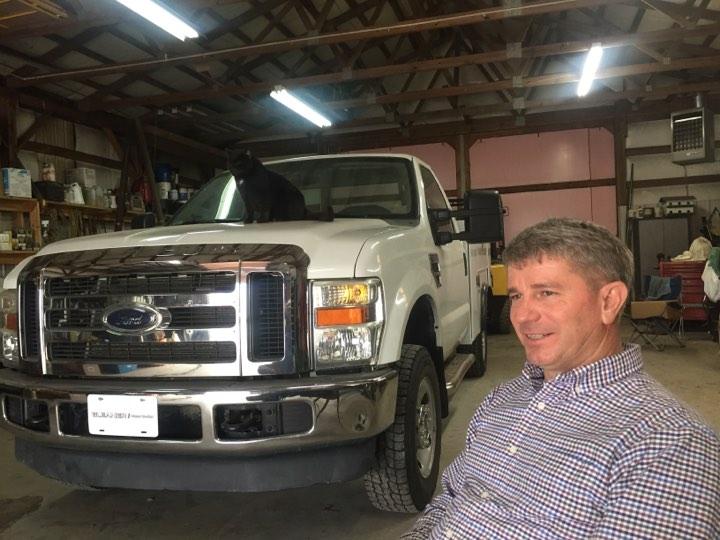An invasive species that costs the federal government $1.5 billion each year is rooting and wrecking parts of Land Between the Lakes in west Kentucky. Officials say feral hogs are a direct threat to the national recreation area's most vital activities
Cadiz farmer Kerry Underhill is frustrated. His family has farmed the same land in LBL for decades, but he is dealing with a new problem. He scrolls through photos on his phone that show huge sections of cornfields totally destroyed.
“We lost 25 percent of our crops over there this past year. About 12-15 percent was lost to feral hogs,” he said.
Feral hogs--believed to be illegally released in the area to hunt for sport--have been a growing issue in LBL since 2016. Underhill said the hogs are a year-long problem. “They’ll go right down the corn row or bean row and pick the seed right up out of the ground- they’ll root it out of the ground, right down each row. They’re in it from the moment it’s planted till the time it’s shelled,” he said.
The threat against farmers is just one of many impacts from the hogs that have LBL officials concerned.
“Their ability to profitably farm at Land Between the Lakes is in jeopardy because of the hogs. For us to manage the open areas, we need those areas to be farmed,” LBL Public Affairs Officer Chris Joyner said.

Joyner meets with officials from local county governments and the Animal and Plant Health Inspection Service, or APHIS to develop more aggressive measures for eliminating the hogs. He said officials trapped and euthanized 70 hogs in 2018. “What really got our attention is as soon as 2019 came around we caught 26 really quick, I mean just in a matter of a couple of weeks,” he said.
Feral hogs are a big problem for the federal government. They damage heritage sites, destroy row crops and can spread disease and parasites. The United States Department of Agriculture has a web page dedicated to the hogs and what people should do if they encounter one. The USDA said feral hogs are found in nearly every country in the southeastern United States and nearly the entire state of California.

Joyner said the hogs threaten LBL’s flora and fauna by digging up plants and eating everything, including young deer and turkeys. “So they have a potential to impact our recreation revenue from the region because people come here to hunt turkeys from all over the country, people come here to hunt deer from all over the country,” he said.
The USDA said even though feral hogs look similar to domestic hogs, they are generally thinner and have thicker hides. They vary in coat and color, have long tusks… and they breed very quickly.

“Female feral swine can actually have two litters a year, they start breeding when they are about six months old and they can have anywhere from four to 10 piglets in a litter,” APHIS Public Affairs Specialist Tanya Espinosa said. “All it takes is a couple of escaped or loose female pigs and you end up with a huge population of feral swine in no time,”
Back in LBL, Chris Joyner said APHIS and the Forest Service recommend aerial gunnings as an aggressive tactic to get rid of the hogs. He said shooting hogs from a helicopter could kill up to 70 per trip. But, aerial gunning on land used for recreation comes with concerns.
“We don’t go into anything like taking a helicopter over public lands that are being recreated by 1.7 million people a year-- we don’t take that lightly. You’re putting an aircraft and shooting out of it-- we’re still now doing the analysis of what it would take to do that safely,” Joyner said.
Joyner said officials don't know how many of the hogs are in LBL. "Our concern was: 'well, we don't know how many we got and with the additional expense of putting an aircraft in the air, we didn't know if that was carrying it to a level of expense that was unwarranted, because we don't know how many hogs there are,'" he said. "Since we had that meeting (with APHIS) we learned that counting every hog is impractical, we know we have a problem, we don't know how many hogs are here."
Joyner said officials will spend the next several months considering what should be done to prepare for aerial gunnings over LBL. He said if officials choose to go through with this tactic, it will begin next winter-as the recreation area is about to enter its busiest season once again.
Though feral hog hunting isn’t discouraged in other parts of the south--it’s not allowed in LBL. Joyner said this is because hogs hide when they’re hunted-- making them harder to locate and trap.
Farmer Kerry Underhill said he would like to be able to hunt the hogs, but understands that it might not be the best approach. "We hunt hogs in Georgia, most of the time if you go into a place and hunt, you won't see hogs there for another week. They're really smart animals, they won't stick around," he said.
Underhill is concerned it’s only a matter of time before the hogs spread beyond the boundaries of LBL. “Our farm is located approximately four miles from Barkley Lake and if the hogs ever start swimming the lake or river- which I know they can- it’s going to be a problem here also,” he said.
Underhill said if the hog problem worsens, he will have to leave the land that his family has farmed for so many years.






